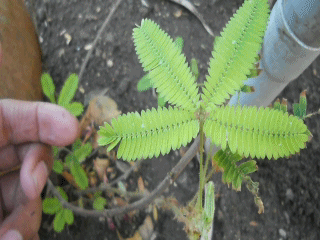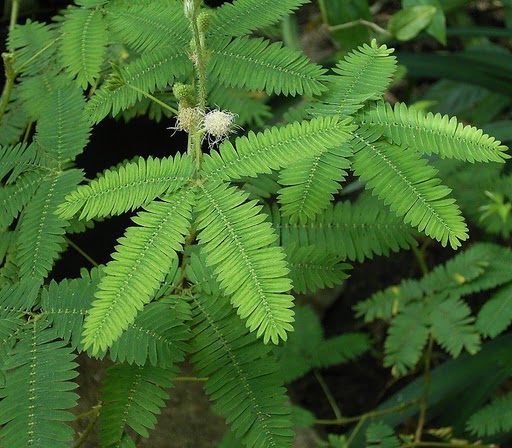When touched, Mimosa pudica bends due to changes in the turgor pressure in its cells. This behavior is a defense mechanism against predators.
Mimosa pudica is a perennial herb from the Fabaceae pea family, native to Central and South America. It is commonly known as the touch-me-not plant, the sensitive plant, or the ‘Tickle Me plant’, and it is famous for closing or folding its leaves when touched.
 The Mimosa pudica closes its leaves after being touched (Source: Wikipedia)
The Mimosa pudica closes its leaves after being touched (Source: Wikipedia)
When it comes to interacting with plants, there is no greater joy than touching the leaves of the “touch-me-not” plant and witnessing their recoil, shrinkage, and “sleeping” state. I used to do this a lot as a child, and I still do it whenever I get the chance. As an adult, I have always wondered what triggers such a response from the plant and how it accomplishes it.
Mimosa Pudica Exhibits Thigmonasty
While this unique plant has many colloquial names, botanists and the scientific community refer to it as Mimosa pudica. It is a perennial herb from the Fabaceae family, belonging to the genus Mimosa, and it is native to Central and South America.
Mimosa pudica is not the only Mimosa plant that showcases “rapid plant movement”; it is simply the most well-known one. In 300 BC, the Greek philosopher Theophrastus mentioned a plant that would “wither up and collapse”, and then revive and thrive after some time. The plant Theophrastus was referring to was likely a species of Mimosa, possibly M. asperata according to some research.
These rapid movements are not exclusive to Mimosa species. Carnivorous plants like the Venus flytrap employ rapid movements to capture their prey. Species such as the cactus Lophophora williamsii and the plant Cornus canadensis disperse their pollen by rapidly shooting out their stamens upon touch. Plants in the Cardamine species have seeds that explode upon touch.
 The famous Touch-Me-Not plant (Image Source: Wikimedia)
The famous Touch-Me-Not plant (Image Source: Wikimedia)
These movements are called nastic movements, which occur in response to a stimulus. If the stimulus is touch or contact, such as wind, they are known as seismonastic movements or thigmonasty. If the stimulus is heat, they are called thermonastic movements. If they are in response to light, the movements are called photonastic, while movements based on day and night are termed nyctinastic movements.
Mimosa Pudica’s Leaves Bend Due To Changes in Turgor Pressure of Its Cells
Mimosa pudica not only responds to seismonastic movements, but it also closes its leaves when exposed to heat. When the plant encounters such stimuli, it undergoes a series of biochemical and bioelectrical changes that enable it to bend inwards.
The movement originates from the pulvinus, which is a pad-like swelling found in the petioles and stems that possess the ability to twist, allowing for movement. The pulvinus consists of two types of cells: extensor cells and flexor cells, which are located opposite each other. When the plant is touched, the extensor cells flex while the flexor cells stretch, resulting in the observed movement.
The bending of the leaves in the Mimosa pudica plant is caused by a change in the turgor pressure of the extensor cells. Turgor pressure refers to the force exerted by the water within the cells on the cell walls, which helps maintain their shape.
When the leaves are touched, this stimulus causes potassium (K+) ions and chlorine (Cl-) ions to leave the cells. This decrease in ion concentration creates a chemical gradient, leading to water molecules leaving the cells through osmosis.
As water leaves the extensor cells, the turgor pressure decreases, causing the cells to become flaccid and bend. Additionally, sucrose may be released from the phloem into the extracellular area of the plant, promoting osmosis.
It has been observed that the cytoskeleton within the extensor and flexor cells also undergoes changes to allow the cells to flex. Furthermore, a stimulus can spread throughout a branch via an electrical signal, similar to a neuron, causing all the leaves on that branch to shut in response.
The exact mechanism of how these electrical signals are propagated in plants is not fully understood. Some research suggests that the signals may travel through companion cells and phloem cells, while others implicate the xylem and changes in its pressure.
The folding and recoiling of the leaves in the Mimosa pudica plant require a significant amount of energy. While the leaves are bent, the plant’s ability to photosynthesize and produce energy is reduced. So why does the plant have such a seemingly wasteful mechanism?
Researchers believe that this trait evolved as a predator avoidance mechanism. By bending the leaves inwards and drooping, it becomes more difficult for herbivores to tear off the leaves, and it also exposes thorns. Drooping also gives the impression that the plant is dead or dying, making it less appealing to predators. Additionally, these rapid movements help the plant dislodge insects that may pose a threat.
However, there is always an energy trade-off involved in predator avoidance behaviors. Studies have shown that the Mimosa plant takes longer to reopen its leaves under high light conditions, indicating that it is willing to take a greater risk to avoid predators when there is an abundance of light.
The response of the Mimosa plant is not consistent for all stimuli. Just like animals can become desensitized or habituated to certain repeated stimuli, especially non-life-threatening ones like a loud, repeating sound, research has found that the Mimosa plant’s movements can also show habituation. A study published in 2014 demonstrated that M. pudica exhibits learning behaviors in response to specific stimuli in favorable environmental conditions. Although research on plant behavior is still in its early stages, it holds promising potential for understanding the learning processes of life and the evolution of such behaviors.
